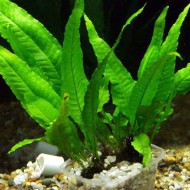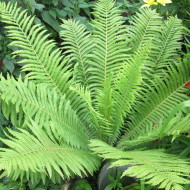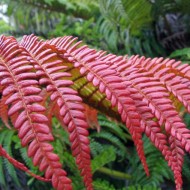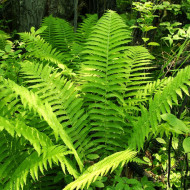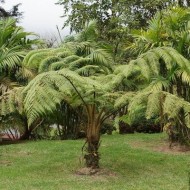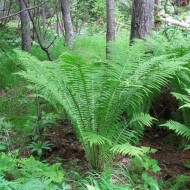Detailed description, useful properties and uses of fern
Content
Description and structural features of the fern
Fern-like (Polypodiophyta) is a whole department that includes about three hundred genera of perennial herbaceous and tree-like plants. All of them can be very different in appearance, however, they have a common brief botanical description. All ferns are made up of three main parts:
- rhizome;
- the escape;
- leaf plates - fronds.

The root is dark brown, thickened, covered with thin filamentous appendages. Ferns have no visible stem - the leaves grow directly from the rhizome. Each leaf sits on a petiole called rachis. The leaf itself in Fern-like is a system of flat shoots. The first shoots appear in May and look like green snails. As they grow, they gradually unfold, taking on a normal appearance.
Since the culture reproduces exclusively by spores or antennae, it does not throw out inflorescences. Sporangia are formed on the lower part of frond, which has a scaly, pinnately complex structure. In autumn, small seeds wake up from them to the ground.
Distribution area
Ferns are incredibly flexible to environmental conditions, and therefore grow throughout the globe. However, they are most often found in tropical or subtropical zones, where high humidity and warm climate prevail. The ubiquitous culture inhabits forests, marshes, mountain slopes, the banks of water bodies, roadsides, and sometimes even grows on tree branches or walls of houses.

Biochemical composition
Low-calorie fern is not in vain so often used in the authentic cuisine of the inhabitants of eastern countries. Such love for this product is due to its complex chemical composition:
- B vitamins;
- tocopherol;
- carotene;
- riboflavin;
- tannins;
- essential oils;
- starch;
- flavonoids;
- organic acids;
- phloroglucinol;
- alkaloids.
Medicinal and useful properties
Fern has a healing effect on the body and helps fight many problems:
- speeds up metabolism;
- stabilizes the functioning of the central nervous system;
- favorably affects the development of the bone skeleton;
- increases tone;
- removes toxins;
- normalizes the functioning of the endocrine system;
- helps to get rid of dermatological problems;
- accelerates wound healing;
- relieves pain syndromes;
- strengthens the heart muscle and blood vessels;
- fights joint diseases;
- relieves of worms.
Video "Fern in the country"
This video describes the features of growing a perennial plant.
Popular views with photos
There are more than ten thousand species of Fern in the world. Below we will briefly talk about the most famous plants cultivated by our growers.
Room
It is a small lush bush no more than half a meter high. The most famous representatives are nephrolepis, maidenhair, davallia, pellea. Indoor ferns are characterized by highly feathery carved leaf plates of various shades of green. The culture prefers shaded areas, grows well on constantly moist soil, needs regular watering.
Thailand
An aquarium variety of culture, which grows to 0.2-0.3 m. It has a long root, from which lanceolate leaves of a bright green herbaceous color with pointed tips grow. Due to the appearance of frond, the fern was named pterygoid. The plant loves a warm aquatic environment (not lower than +24 ° C) with a neutral acidity level, good lighting and regular feeding.
Indian
Another representative of the aquatic flora that grows in ponds or aquariums. Unlike the previous variety, it has small, carved, highly branched shoots of a dark green color. The root system is well developed, but rather fragile. The height of an adult plant reaches 0.5-0.6 m.
The culture does not tolerate direct sunlight and feels more comfortable in partial shade.
Tropical
A low-growing variety that grows up to 0.2 m and is distinguished by the adventitious type of rhizome. The leaf plates have an openwork structure, which gives the vayam a similarity to lace. Some species of tropical ferns love the sun, so like lianas they climb up tree trunks closer to the light source. However, there are also moss species that live in shaded areas near a source of moisture.
- Room
- Thailand
- Indian
- Tropical
Red
It is a low, slow-growing spreading bushes about half a meter high. This species is characterized by a burgundy-purple hue, which is present in the main green color. The most famous varieties are Red Beauty and Lady in Red. They have lush, pinnately dissected leaves with a brown-beetroot sheen, as well as dark red petioles. Plants tolerate winter well, do not need complex care.
Male
A bright green herbaceous perennial with unusual wavy leaves. It is known for the healing properties of the root, which is often used by folk healers. The culture got its name for the structure of fronds, which are coarser in appearance than other varieties. Also, the male fern is characterized by an earlier development of sporangia (July-August). Bushes grow well in partial shade next to other plants.
Tree-like
A tall group, characterized by stiff shoots, on which are located large, strongly dissected fronds of different shades of green color. Most often, the species is found in the subtropical zone, in humid forests, near rivers or lakes, in swampy areas. It reproduces, like other fern species, by spores. The plant is undemanding to environmental conditions, easily adapts to climatic changes.
Forest
This species is also known by other names: bracken fern, shitnikov, mnogoryadnik, ostrich or leaflet. Growing up, it can reach about a meter in height, forming a sprawling funnel-shaped bush. The leaf plates are large, with a rich herbaceous hue, pinnate or dissected-pinnate. The culture is frost-resistant, feels good in the regions of the middle zone, has disinfecting properties.
- Red
- Male
- Tree-like
- Forest
Features of growing a fern
Cultivating perennials at home or in your garden plots requires a careful approach. Read about the features of agricultural technology for Fern crops below.
Location and soil
So that the fronds do not wither, and the rich herbaceous color does not fade, the perennial should be planted in the northern or western areas, where diffused lighting prevails. Culture also responds well to artificial light. When it comes to indoor varieties, then the room where the flowers are kept must be well ventilated.
The soil for the plant is chosen light, with good penetrating ability. It can be a store substrate or one prepared by hand (soil from coniferous crops, peat, sand, dry needles) and heat-treated.
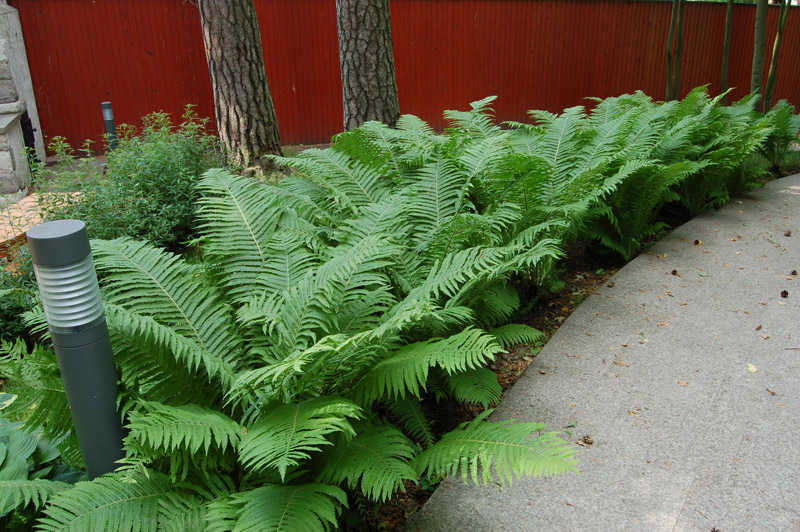
Subtleties of care
Ferns need regular, moderate watering. Moistening is carried out every two to three days, making sure that the top layer of the earth does not dry out. Water is used standing rainwater, at room temperature. Since the plant loves high humidity, it is irrigated twice a week over the foliage and kept away from heating appliances (if it is an indoor flower).
For the winter, the culture goes into a state of dormancy. Since autumn, watering is gradually reduced, and fertilizers are stopped. If the fern grows on the windowsill, the ambient temperature is lowered to +18 ° C. Winter-hardy species planted in the yard do not require additional shelter.
Protection against diseases and pests
Fern-like perennials are very rarely affected by fungal or viral infections. All the problems that growers sometimes face come from improper care. If moisture stagnates in the soil, the rhizome may begin to rot. They save the plant by digging it out of the ground, removing the affected part and transplanting it to a new place. For prophylaxis, you can use a solution of a fungicide (for example, "Fundazol"). Spraying on the bush with preparations such as "Aktara" or "Actellik" will help from aphids, spider mites or scale insects.
Preparation of medicinal raw materials
For the preparation of medicines, folk healers use fern root. It is harvested in the first half of autumn, before the first frost. Having dug up, the rhizome is cleared of the earth, filamentous shoots and scaly leaves are cut off. Next, the raw materials are laid out to dry (this can be an oven or a well-ventilated attic). The finished roots are stored for a year, laid out in glass containers with tight lids.

Fern applications
Most often, a medicinal decoction is prepared on the basis of perennial roots. To do this, grind to a powdery state 2 tsp. dry raw materials, and then steamed it with a glass of boiling water. The workpiece is boiled until the volume of the liquid has evaporated to half. The finished remedy is taken in 1 tsp, diluted with a little honey.
For external use, another simple recipe is used - 70 g of dry roots are poured with a liter of boiling water and simmered over low heat for at least two hours. The cooled broth is filtered, and the sore spots are lubricated with the resulting liquid or added to the bath.
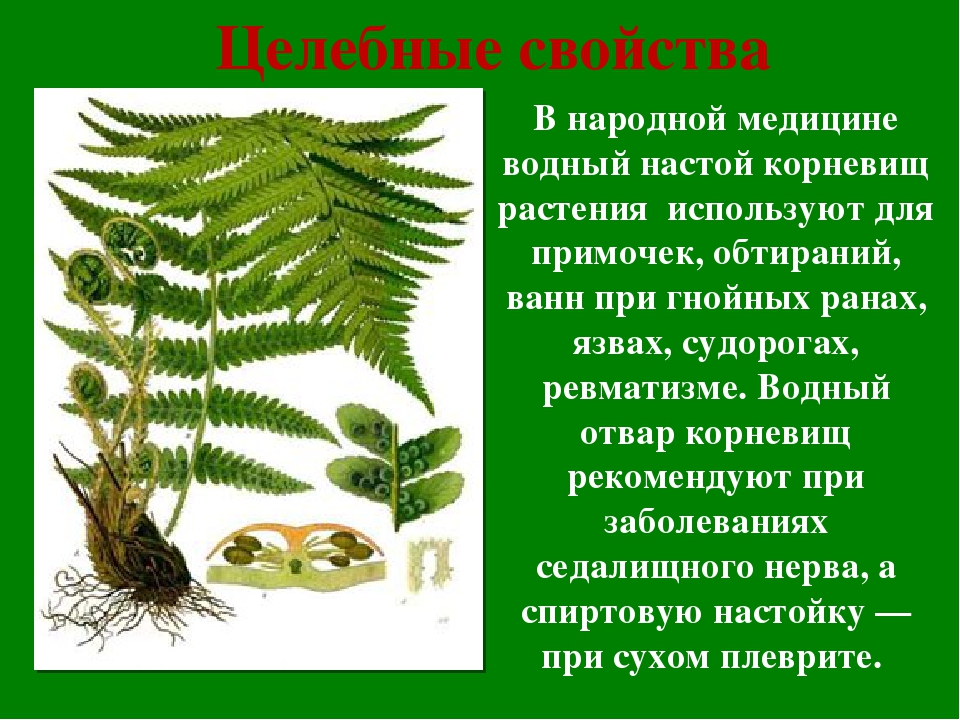
Harm and contraindications for use
Fern contains a large amount of hydrocyanic acid and alkaloids, and therefore is the strongest poisonous substance. It is necessary to take medicines based on perennials only under the supervision of a doctor or herbalist. The reception of the following groups of people is categorically contraindicated:
- pregnant women and women during lactation;
- children under three years old;
- patients with chronic diseases of internal organs;
- patients with anemia or tuberculosis.
In case of an overdose, nausea, severe vomiting, headaches, convulsions are observed. Having identified these symptoms, it is necessary to clear the stomach, drink a sorbent and immediately consult a doctor.
Fern-like perennials are the oldest plants that have existed for more than one million years. Their beneficial properties were already known to our distant ancestors, and the recipes for some medicines have survived to this day.


